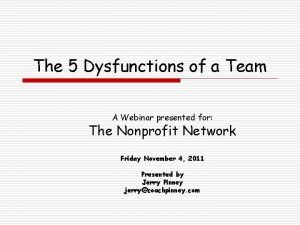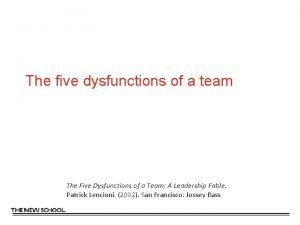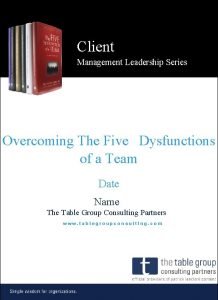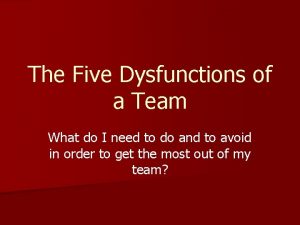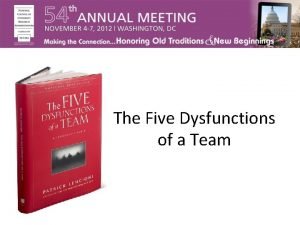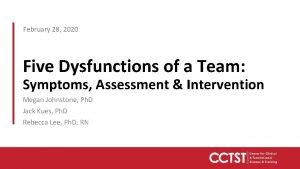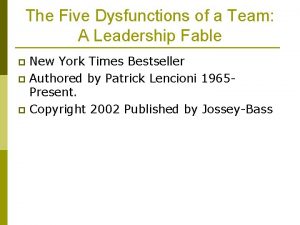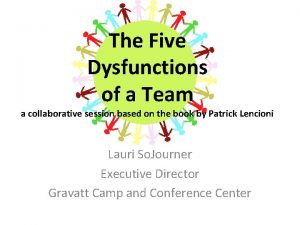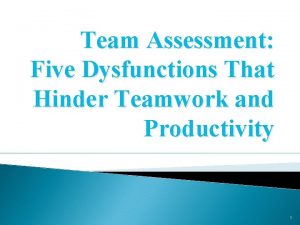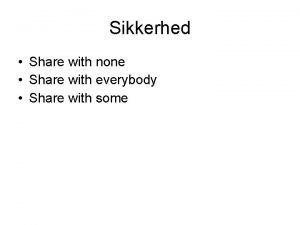We Share Ideas The FIVE Dysfunctions of a

























- Slides: 25

We Share Ideas

The FIVE Dysfunctions of a Team A Leadership Fable by Patrick Lencioni We Share Ideas

What’s the Best Competitive Advantage? • Not Finance • Not Strategy • Not Technology • It’s Teamwork • The Ultimate Competitive Advantage • So Powerful • So Rare We Share Ideas

Teamwork -- Where? Sr. Managers CEO Finance Sales A/R Inside A/P Outside Marketing Middle Mgrs. Distr. Mfg. Departments We Share Ideas Operations HR

The Five Dysfunctions of a Team Absence of Trust We Share Ideas Invulnerability

The Five Dysfunctions of a Team Fear of Conflict Absence of Trust We Share Ideas Artificial Harmony Invulnerability

The Five Dysfunctions of a Team Lack of Commitment Fear of Conflict Absence of Trust We Share Ideas Ambiguity Artificial Harmony Invulnerability

The Five Dysfunctions of a Team Avoidance of Accountability Lack of Commitment Fear of Conflict Absence of Trust We Share Ideas Low Standards Ambiguity Artificial Harmony Invulnerability

The Five Dysfunctions of a Team Inattention to Results Avoidance of Accountability Lack of Commitment Fear of Conflict Absence of Trust We Share Ideas Status and Ego Low Standards Ambiguity Artificial Harmony Invulnerability

Dysfunction 1: Absence of Trust Members of teams with an absence of trust. . . • Conceal their weaknesses & mistakes from one another • Hesitate to ask for help or provide constructive feedback • Hesitate to offer help outside their own area of responsibility • Jump to conclusions about the intentions and aptitudes of others without attempting to clarify them • Fail to recognize and tap into one another’s skills and experiences • Waste time and energy managing their behaviors for effect • Hold grudges • Dread meetings and find reasons to avoid spending time together We Share Ideas

Dysfunction 1: Absence of Trust Members of trusting teams. . . • Admit weaknesses & mistakes • Ask for help • Accept questions and input about their areas of responsibility • Give one another the benefit of the doubt before arriving at a negative conclusion • Take risks in offering feedback and assistance • Appreciate and tap into one another’s skills and experiences • Focus time and energy on important issues, not politics • Offer and accept apologies without hesitation • Look forward to meetings and other opportunities to work as a group We Share Ideas

Questions • • Symptoms of an absence of trust Evidence of a team that trusts each other We Share Ideas

Dysfunction 2: Fear of Conflict Teams that fear conflict. . . • Have boring meetings • Create environments where back-channel politics and personal attacks thrive • Ignore controversial topics that are critical to team success • Fail to tap into all the opinions and perspectives of team members • Waste time and energy with posturing and interpersonal risk management We Share Ideas

Dysfunction 2: Fear of Conflict Teams that engage in conflict. . . • • • Have lively, interesting meetings Extract and exploit the ideas of all team members Solve real problems quickly Minimize politics Put critical topics on the table for discussion We Share Ideas

Questions • • Symptoms of fear of conflict Evidence of a team that engages in conflict We Share Ideas

Dysfunction 3: Failure to Commit A Team that fails to commit. . . • Creates ambiguity among the team about direction and priorities • Watches windows of opportunity close due to excessive analysis and unnecessary delay • Breeds lack of confidence and fear of failure • Revisits discussions and decisions again and again • Encourages second-guessing among team members We Share Ideas

Dysfunction 3: Failure to Commit A Team that commits. . . • • • Creates clarity around direction and priorities Aligns the entire team around common objectives Develops an ability to learn from mistakes Takes advantage of opportunities before competitors do Moves forward without hesitation Changes direction without hesitation or guilt We Share Ideas

Questions • • Symptoms of failure to commit Evidence of a team that commits We Share Ideas

Dysfunction 4: Avoidance of Accountability A Team that avoids accountability. . . • Creates resentment among team members who have different standards of performance • Encourages mediocrity • Misses deadlines and key deliverables • Places an undue burden on the team leader as the sole source of discipline We Share Ideas

Dysfunction 4: Avoidance of Accountability A Team that holds one another accountable. . . • Ensures that poor performers feel pressure to improve • Identifies potential problems quickly by questioning one another’s approaches without hesitation • Establishes respect among team members who are held to the same high standards • Avoids excessive bureaucracy around performance management and corrective action We Share Ideas

Questions • • Symptoms of a team that avoids accountability Evidence of a team that holds each other accountable We Share Ideas

Dysfunction 5: Inattention to Results A Team that is not focused on results. . . • • Stagnates/fails to grow Rarely defeats competitors Loses achievement-oriented employees Encourages team members to focus on their own careers and individual goals • Is easily distracted We Share Ideas

Dysfunction 5: Inattention to Results A Team that focuses on collective results. . . • • Retains achievement-oriented employees Minimizes individualistic behavior Enjoys success and suffers failure acutely Benefits from individuals who subjugate their own goals/interests for the good of the team • Avoids distractions We Share Ideas

Questions • • Symptoms of a team that is not focused on results Evidence of a team that is focused on results We Share Ideas

The FIVE Dysfunctions of a Team A Leadership Fable by Patrick Lencioni We Share Ideas
 5 dysfunctions of a team powerpoint
5 dysfunctions of a team powerpoint 5 dysfunctions of a team questions
5 dysfunctions of a team questions Dysfunctions of deviance
Dysfunctions of deviance Safety share ideas
Safety share ideas Absence of trust
Absence of trust Ideas have consequences bad ideas have victims
Ideas have consequences bad ideas have victims Ideas principales e ideas secundarias
Ideas principales e ideas secundarias Macbeth act five scene one
Macbeth act five scene one The sounding cataract haunted me
The sounding cataract haunted me One in five challenge
One in five challenge 5 elements and 5 senses
5 elements and 5 senses Sự nuôi và dạy con của hươu
Sự nuôi và dạy con của hươu điện thế nghỉ
điện thế nghỉ Một số thể thơ truyền thống
Một số thể thơ truyền thống Thế nào là sự mỏi cơ
Thế nào là sự mỏi cơ Trời xanh đây là của chúng ta thể thơ
Trời xanh đây là của chúng ta thể thơ Voi kéo gỗ như thế nào
Voi kéo gỗ như thế nào Thế nào là số nguyên tố
Thế nào là số nguyên tố Thiếu nhi thế giới liên hoan
Thiếu nhi thế giới liên hoan Tỉ lệ cơ thể trẻ em
Tỉ lệ cơ thể trẻ em Phối cảnh
Phối cảnh Các châu lục và đại dương trên thế giới
Các châu lục và đại dương trên thế giới Thế nào là hệ số cao nhất
Thế nào là hệ số cao nhất Hệ hô hấp
Hệ hô hấp Tư thế ngồi viết
Tư thế ngồi viết Hát kết hợp bộ gõ cơ thể
Hát kết hợp bộ gõ cơ thể

